Refractured Well Hydraulic Fractures Optimization in Tight Sandstone Gas Reservoirs: Application in Linxing Gas Field
Abstract
:1. Introduction
2. Methodology
- (1)
- The reservoir boundary exhibits a constant width and length, the hydraulic fracture fully penetrates the reservoir, and the fracture branch after refracturing is shown in Figure 1;
- (2)
- The height, porosity, and permeability do not change in homogeneous and isotropic reservoirs;
- (3)
- Compressible single-phase gas flow occurs in reservoirs with a constant compressibility coefficient and viscosity;
- (4)
- Complex secondary fractures with enhanced permeability are created by refracturing;
- (5)
- The main fracture’s dynamic conductivity decreases over time.
3. Mathematical Model
3.1. Reservoir Seepage Model
3.2. Induced Fracture Networks
3.3. Main Fracture Flow Model
3.4. Dynamic Conductivity Evolution
3.5. Coupled Model
4. Model Solution and Verification
4.1. The Solution Method
4.2. Model Verification
5. Application: Tight Gas Reservoir in Linxing Field
5.1. Reservoir Characteristics
5.2. Analysis
5.3. Optimization
6. Conclusions
- (1)
- To ensure effective recovery and enhance production, the refracture job should be carried out as soon as possible when daily production is lower than the desired value;
- (2)
- Restoring the initial fractures (Cf-ini) and constructing the refractures (Cf-ref), conductivity can increase productivity, which increases over 8 D•cm; the production growth rate just obtains a slight improvement; both optimal Cf-ini and Cf-ref are 8 D•cm, which is recommended in this field case;
- (3)
- Extending the initial fractures and creating the refractures means more reservoirs can be developed, and the daily production significantly increases with Lf-ini increasing from 120~270 m and Lf-ref increasing from 100~150 m. Hence, it is essential to extend the length of the initial fracture as much as possible under engineering conditions; the optimal Lf-ini is 220 m and Lf-ref is 150 in this field case;
- (4)
- In a tight sand gas reservoir, the ks/km = 10 can obviously increase production, but for enlarged fracture networks, the permeability ks does not contribute to well performance. Conversely, further producing larger stimulated width bs is vital to enhance production for the refracture job;
- (5)
- The orthogonal experiments indicate that the optimal hydraulic fracture parameter combinations with important rank for well(X1) are: ds (4 m) > Lf-ini (220 m) > Lf-ref (100 m) > Cf-ini (8 D•cm) > ks (5 mD) > Cf-ref (10 D•cm). Based on the optimal design, the productivity of well(X1) recovery is more than 90% after the refracture job.
Author Contributions
Funding
Data Availability Statement
Conflicts of Interest
Nomenclature
| Variable | |
| pseudopressure function of the reservoir, MPa/mPa∙s | |
| initial pseudopressure function value of the reservoir, MPa/mPa∙s | |
| pseudopressure function value at the bottom of the well, MPa/mPa∙s | |
| conductance coefficient, cm2/s | |
| comprehensive compressibility, MPa−1 | |
| porosity, dimensionless | |
| t | production time, days; |
| km | reservoir permeability, μm2 |
| μg | gas viscosity, mPa∙s |
| initial reservoir pressure, MPa | |
| reservoir pressure at position (x, y, z) on day t, MPa | |
| source coefficient between segment k and the reservoir segment. | |
| gas deviation factor, with a value of 1, dimensionless | |
| gas deviation factor under standard conditions, dimensionless | |
| temperature, K | |
| temperature under standard conditions, K | |
| pressure under standard conditions, MPa | |
| pressure under ambient conditions, MPa | |
| Bg | gas reservoir volume factor, dimensionless |
| slab source functions in x dimension | |
| slab source functions in y dimension | |
| slab source functions in z dimension | |
| h | reservoir height, m |
| pressure drop between and reservoir nodes, MPa | |
| initial reservoir pressure, MPa | |
| reservoir node pressure at time t, MPa | |
| flow rate attributed to the k-th reservoir node, m3/d | |
| flow rate attributed to the k-th fracture node, m3/d | |
| n | time discrete step, dimensionless. |
| g | intermediate variable of time discrete step, dimensionless. |
| sffk | negative skin factor, dimensionless |
| flow rate under standard conditions per unit area, m3/d | |
| secondary fracture permeability, μm2 | |
| k-th node stimulated area width, m | |
| secondary fracture pressure drop, MPa2 | |
| secondary fractures induced additional pressure drop, MPa2 | |
| pwf | bottom hole pressure, MPa |
| main fracture permeability, μm2 | |
| dynamic conductivity test time, days | |
| refracture time, days | |
| dynamic permeability of the k-th main fracture node, μm2 | |
| width of the k-th main fracture node, m | |
| conductivity of the main fracture, D•cm (μm2•cm) | |
| dynamic conductivity of the k-th main fracture node, μm2∙cm | |
| Q | total production of the refractured gas well, m3/d |
| GR | the growth rate, % |
| Subscript | |
| x | x dimension |
| y | y dimension |
| z | z dimension |
| e | reservoir boundary |
| w | well bottom |
| r | reservoir property |
| s | secondary fracture property |
| f | fracture property |
| k | discrete node index |
| sc | standard condition |
| air | atmospheric conditions |
| g | gas property |
| i, j | intermediate variable of node index |
| ini | initial fracture |
| ref | refracture |
Appendix A. Derivation of Coefficient Fk (x, y, z, t)
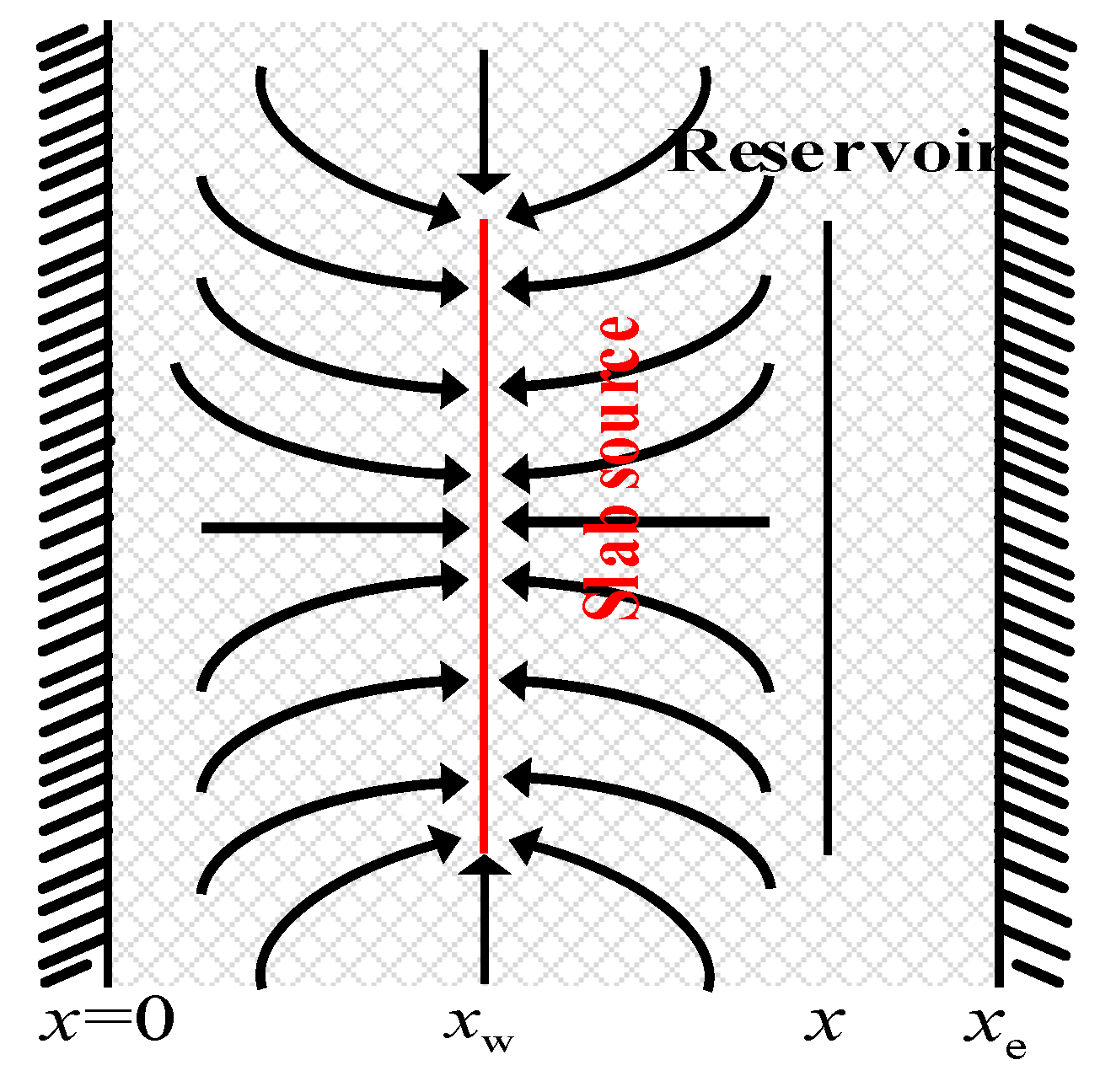
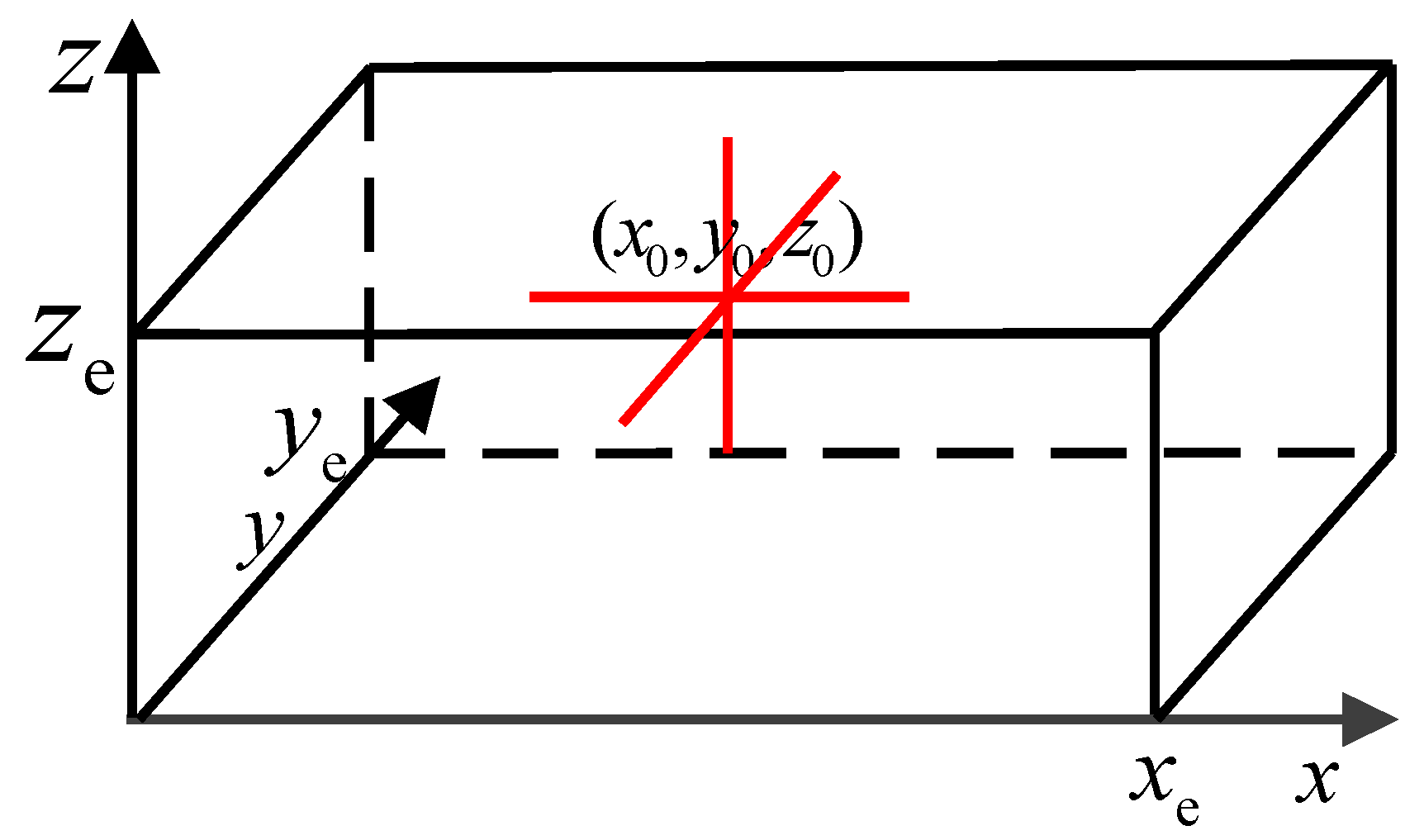
Appendix B. Brief Solution for Nodal Equations
References
- Holditch, S.A. Tight Gas Sands. J. Pet. Technol. 2006, 58, 86–93. [Google Scholar] [CrossRef]
- Guo, S.; Li, Y.; Chen, T.; Zheng, D.; Du, J.; Bu, Y.; Zhou, A.; Pang, X.; Liu, H. Controlling the hydration rate of alkali-activated slag by the slow release of NaOH. Geoenergy Sci. Eng. 2023, 228, 211960. [Google Scholar] [CrossRef]
- Zeng, F.; Yang, B.; Guo, J.; Chen, Z.; Xiang, J. Experimental and Modeling Investigation of Fracture Initiation from Open-Hole Horizontal Wells in Permeable Formations. Rock Mech. Rock Eng. 2019, 52, 1133–1148. [Google Scholar] [CrossRef]
- Wang, J.Y.; Holditch, S.; Mcvay, D. Modeling fracture-fluid cleanup in tight-gas wells. SPE J. 2010, 15, 783–793. [Google Scholar] [CrossRef]
- Jacobs, T. Renewing Mature Shale Wells through Refracturing. J. Pet. Technol. 2014, 66, 52–60. [Google Scholar] [CrossRef]
- Snyder, D.; Seale, R.A. Optimization of Completions in Unconventional Reservoirs for Ultimate Recovery-Case Studies. In Proceedings of the SPE EUROPEC/EAGE Annual Conference and Exhibition, Vienna, Austria, 23–27 May 2011; Society of Petroleum Engineers: Richardson, TX, USA. [Google Scholar]
- Cramer, D.D. Fracture Skin: A Primary Cause of Stimulation Ineffectivenessas in Gas Wells. In Proceedings of the SPE Annual Technical Conference and Exhibition, San Antonio, TX, USA, 9–11 October 2005; Society of Petroleum Engineers: Richardson, TX, USA. [Google Scholar]
- Ding, D.Y.; Langouët, H.; Jeannin, L. Simulation of fracturing-induced formation damage and gas production from fractured wells in tight gas reservoirs. SPE Prod. Oper. 2013, 28, 246–258. [Google Scholar] [CrossRef]
- Wen, Q.; Zhang, S.; Wang, L.; Liu, Y.; Li, X. The effect of proppant embedment upon the long-term conductivity of fractures. J. Pet. Sci. Eng. 2007, 55, 221–227. [Google Scholar] [CrossRef]
- Barree, R.D.; Miskimins, J.L.; Svatek, K.J. Reservoir and completion considerations for the refracturing of horizontal wells. SPE Prod. Oper. 2018, 33, 1–11. [Google Scholar] [CrossRef]
- Shah, M.; Shah, S.; Sircar, A. A comprehensive overview on recent developments in refracturing technique for shale gas reservoirs. J. Nat. Gas Sci. Eng. 2017, 46, 350–364. [Google Scholar] [CrossRef]
- Akbari, M.; Ameri, M.J.; Kharazmi, S.; Motamedi, Y.; Pournik, M. New correlations to predict fracture conductivity based on the rock strength. J. Pet. Sci. Eng. 2017, 152, 416–426. [Google Scholar] [CrossRef]
- Shamsi, M.M.M.; Nia, S.F.; Jessen, K. Dynamic conductivity of proppant-filled fractures. J. Pet. Sci. Eng. 2017, 151, 183–193. [Google Scholar] [CrossRef]
- Lindsay, G.J.; White, D.J.; Miller, G.A.; Baihly, J.D.; Sinosic, B. Understanding the applicability and economic viability of refracturing horizontal wells in unconventional plays. In Proceedings of the SPE Hydraulic Fracturing Technology Conference, The Woodlands, TX, USA, 9–11 February 2016; Society of Petroleum Engineers: Richardson, TX, USA. [Google Scholar]
- Teng, B.; Li, H.A. A Semianalytical Model for Evaluating the Performance of a Refractured Vertical Well with an Orthogonal Refracture. SPE J. 2019, 24, 891–911. [Google Scholar] [CrossRef]
- Luo, L.; Cheng, S.; Lee, J. Characterization of refracture orientation in poorly propped fractured wells by pressure transient analysis: Model, pitfall, and application. J. Nat. Gas Sci. Eng. 2020, 79, 103332. [Google Scholar] [CrossRef]
- Sophie, S.Y.; Sharma, M.M. A new method to calculate slurry distribution among multiple fractures during fracturing and refracturing. J. Pet. Sci. Eng. 2018, 170, 304–314. [Google Scholar]
- Li, W.; Zhao, H.; Pu, H.; Zhang, Y.; Wang, L.; Zhang, L.; Sun, X. Study on the mechanisms of refracturing technology featuring temporary plug for fracturing fluid diversion in tight sandstone reservoirs. Energy Sci. Eng. 2019, 7, 88–97. [Google Scholar] [CrossRef]
- Zeng, F.; Guo, J. Optimized design and use of induced complex fractures in horizontal wellbores of tight gas reservoirs. Rock Mech. Rock Eng. 2016, 49, 1411–1423. [Google Scholar] [CrossRef]
- Zeng, F.; Zhang, Y.; Guo, J.; Zhang, Q.; Chen, Z.; Xiang, J.; Zheng, Y. Optimized completion design for triggering a fracture network to enhance horizontal shale well production. J. Pet. Sci. Eng. 2020, 190, 107043. [Google Scholar] [CrossRef]
- Dusterhoft, R.G.; East, L.E.; Soliman, M.Y. Fracturing a Stress-Altered Subterranean Formation. U.S. Patent 8,210,257, 3 July 2012. [Google Scholar]
- Mohaghegh, S.; Mohamad, K.; Popa, A.; Ameri, S.; Wood, D. Performance drivers in restimulation of gas-storage wells. SPE Reserv. Eval. Eng. 2001, 4, 536–542. [Google Scholar] [CrossRef]
- Roussel, N.P.; Sharma, M.M. Selecting candidate wells for refracturing using production data. SPE Prod. Oper. 2013, 28, 36–45. [Google Scholar] [CrossRef]
- Warpinski, N.R.; Branagan, P.T. Altered-stress fracturing. J. Pet. Technol. 1989, 41, 990–997. [Google Scholar] [CrossRef]
- Roussel, N.P.; Sharma, M.M. Quantifying transient effects in altered-stress refracturing of vertical wells. SPE J. 2010, 15, 770–782. [Google Scholar] [CrossRef]
- Oruganti, Y.; Mittal, R.; McBurney, C.J.; Rodriguez, A. Re-fracturing in eagle ford and Bakken to increase reserves and generate incremental NPV: Field study. In Proceedings of the SPE Hydraulic Fracturing Technology Conference, The Woodlands, TX, USA, 3–5 February 2015; Society of Petroleum Engineers: Richardson, TX, USA. [Google Scholar]
- Teng, B.; Li, H.A. A semi-analytical model for characterizing the fluid transient flow of reoriented refractures. J. Pet. Sci. Eng. 2019, 177, 921–940. [Google Scholar] [CrossRef]
- Zhou, W.; Banerjee, R.; Poe, B.D.; Spath, J.; Thambynayagam, M. Semianalytical production simulation of complex hydraulic-fracture networks. SPE J. 2013, 19, 6–18. [Google Scholar] [CrossRef]
- Hazlett, R.D.; Babu, D.K. Discrete wellbore and fracture productivity modeling for unconventional wells and unconventional reservoirs. SPE J. 2014, 19, 19–33. [Google Scholar] [CrossRef]
- Ostojic, J.; Rezaee, R.; Bahrami, H. Production performance of hydraulic fractures in tight gas sands, a numerical simulation approach. J. Pet. Sci. Eng. 2012, 88, 75–81. [Google Scholar] [CrossRef]
- Suzuki, K. Influence of wellbore hydraulics on horizontal well pressure transient behavior. SPE Form. Eval. 1997, 12, 175–181. [Google Scholar] [CrossRef]
- Yao, S.; Zeng, F.; Liu, H.; Zhao, G. A semi-analytical model for multi-stage fractured horizontal wells. J. Hydrol. 2013, 507, 201–212. [Google Scholar] [CrossRef]
- Pan, Y.; Kamal, M.M.; Kikani, J. Field applications of a semianalytical model of multilateral wells in multilayer reservoirs. SPE Reserv. Eval. Eng. 2010, 13, 861–872. [Google Scholar] [CrossRef]
- He, Y.; Cheng, S.; Li, S.; Huang, Y.; Qin, J.; Hu, L.; Yu, H. A semianalytical methodology to diagnose the locations of underperforming hydraulic fractures through pressure-transient analysis in tight gas reservoir. SPE J. 2017, 22, 924–939. [Google Scholar] [CrossRef]
- Yang, R.; Huang, Z.; Li, G.; Yu, W.; Sepehrnoori, K.; Lashgari, H.R.; Tian, S.; Song, X.; Sheng, M. A semianalytical approach to model two-phase flowback of shale-gas wells with complex-fracture-network geometries. SPE J. 2017, 22, 1808–1833. [Google Scholar] [CrossRef]
- He, J.; Okere, C.J.; Su, G.; Hu, P.; Zhang, L.; Xiong, W.; Li, Z. Formation damage mitigation mechanism for coalbed methane wells via refracturing with fuzzy-ball fluid as temporary blocking agents. J. Nat. Gas Sci. Eng. 2021, 90, 103956. [Google Scholar] [CrossRef]
- Horne, R. The Fenske conservation method for pressure transient solutions with storage. Soc. Pet. Eng. J. 1985, 25, 437–444. [Google Scholar] [CrossRef]
- Yu, W.; Wu, K.; Sepehrnoori, K. A Semianalytical Model for Production Simulation from Nonplanar Hydraulic-Fracture Geometry in Tight Oil Reservoirs. SPE J. 2016, 21, 1028–1040. [Google Scholar] [CrossRef]
- Lin, J.; Zhu, D. Predicting Well Performance in Complex Fracture Systems by Slab Source Method. In Proceedings of the SPE Hydraulic Fracturing Technology Conference and Exhibition, The Woodlands, TX, USA, 6–8 February 2012. [Google Scholar]
- Lin, J.; Zhu, D. Modeling well performance for fractured horizontal gas wells. J. Nat. Gas Sci. Eng. 2014, 18, 180–193. [Google Scholar] [CrossRef]
- Clarkson, C.R. Production data analysis of unconventional gas wells: Review of theory and best practices. Int. J. Coal Geol. 2013, 109–110, 101–146. [Google Scholar] [CrossRef]
- Zeng, J.; Wang, X.; Guo, J.C. Composite linear flow model for multi-fractured horizontal wells in heterogeneous shale reservoir. J. Nat. Gas Sci. Eng. 2017, 38, 527–548. [Google Scholar] [CrossRef]
- Lian, P.; Cheng, L.; Cui, J. A new computation model of fractured horizontal well coupling with reservoir. Int. J. Numer. Methods Fluids 2011, 67, 1047–1056. [Google Scholar] [CrossRef]
- Cinco, L.; Samaniego, V.; Dominguez, A. Transient pressure behavior for a well with a finite-conductivity vertical fracture. Soc. Pet. Eng. J. 1978, 18, 253–264. [Google Scholar] [CrossRef]
- Van Everdingen, A.F. The Skin Effect and Its Influence on the Productive Capacity of a Well. J. Pet. Technol. 1953, 5, 171–176. [Google Scholar] [CrossRef]
- Tayong, R.; Alhubail, M.M.; Maulianda, B.; Barati, R. Simulating yield stress variation along hydraulic fracture face enhances polymer cleanup modeling in tight gas reservoirs. J. Nat. Gas Sci. Eng. 2019, 65, 32–44. [Google Scholar] [CrossRef]
- Kuchuk, F.J.; Goode, P.A.; Wilkinson, D.J.; Thambynayagam, R.K.M. Pressure-Transient Behavior of Horizontal Wells with and without Gas Cap or Aquifer. SPE Form. Eval. 1991, 6, 86–94. [Google Scholar] [CrossRef]
- Zhang, Z.; Guo, J.; Liang, H.; Liu, Y. Numerical simulation of skin factors for perforated wells with crushed zone and drilling-fluid damage in tight gas reservoirs. J. Nat. Gas Sci. Eng. 2021, 90, 103907. [Google Scholar] [CrossRef]
- Zeng, F.H.; Cheng, X.Z.; Guo, J.C.; Long, C.; Ke, Y. A New Model to Predict the Unsteady Production of Fractured Horizontal Wells (Model Baharu untuk Meramalkan Pengeluaran tak Menentu Telaga Mendatar yang Retak). Sains Malays. 2016, 45, 1579–1587. [Google Scholar]

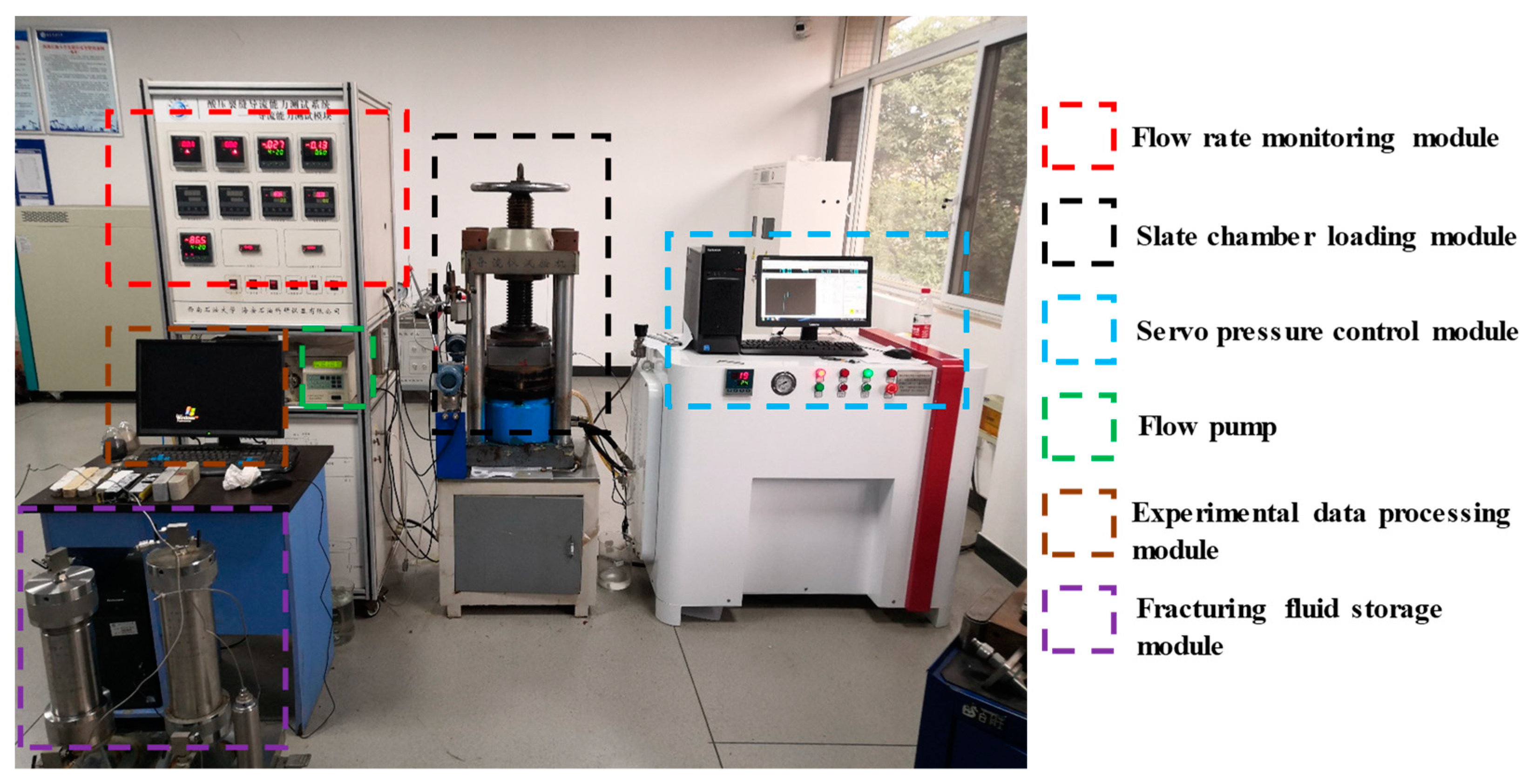

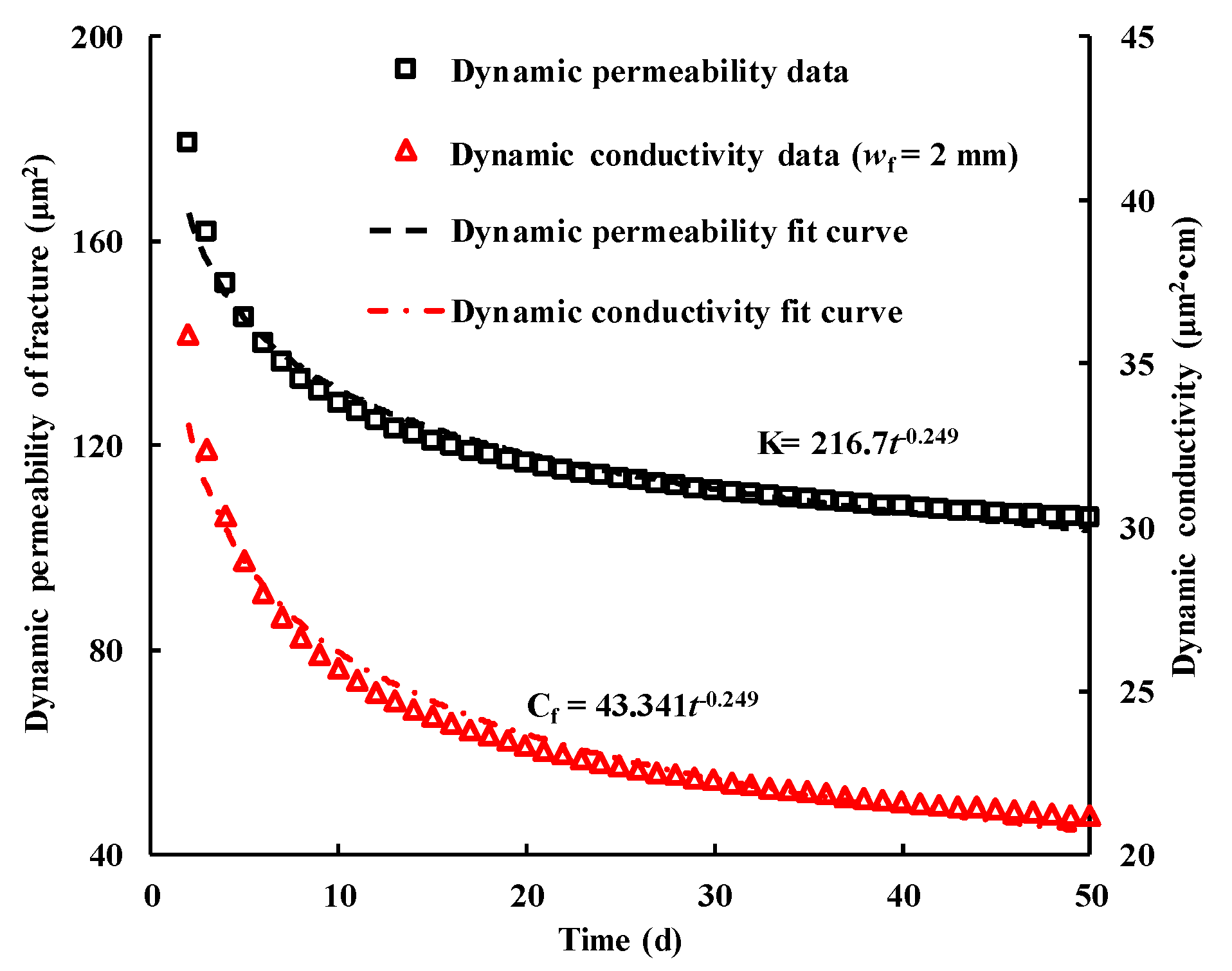

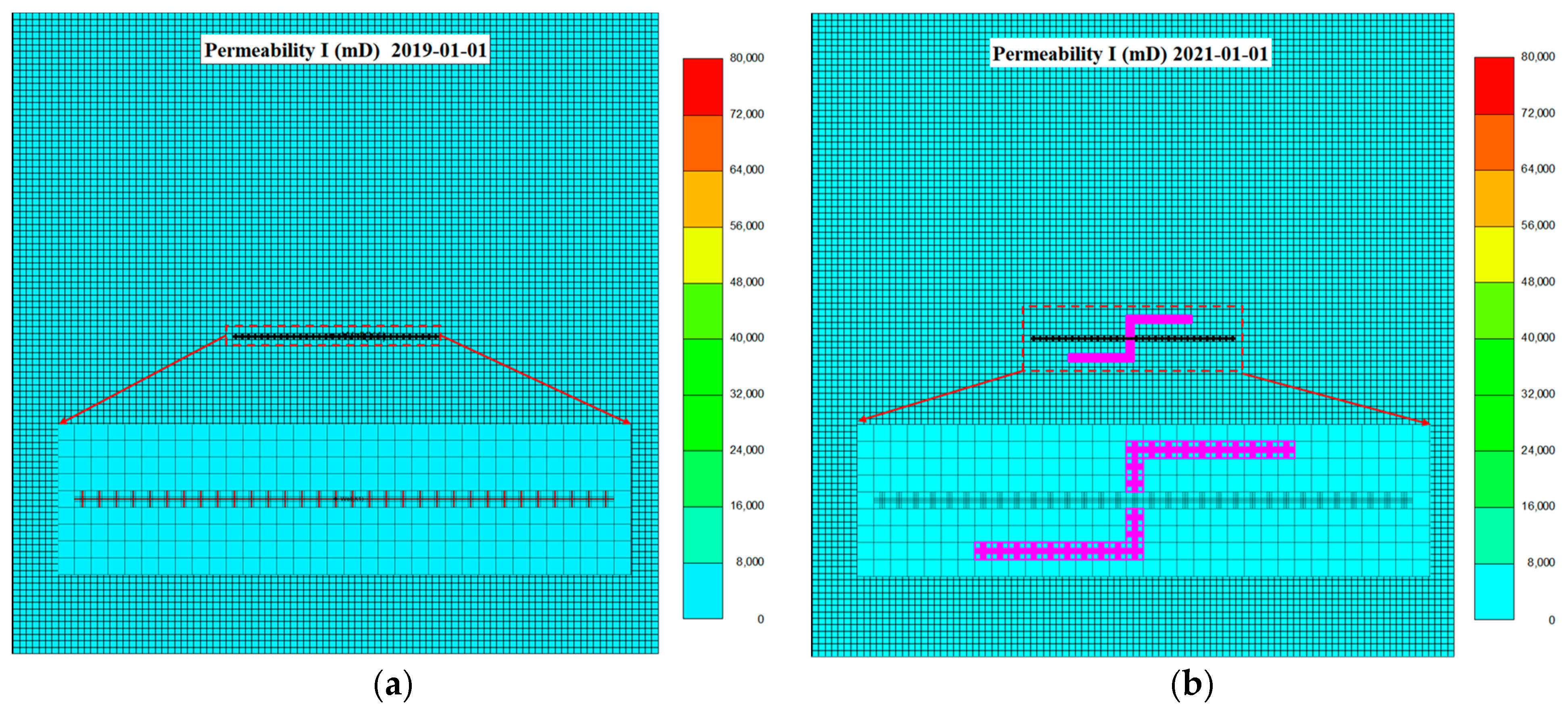
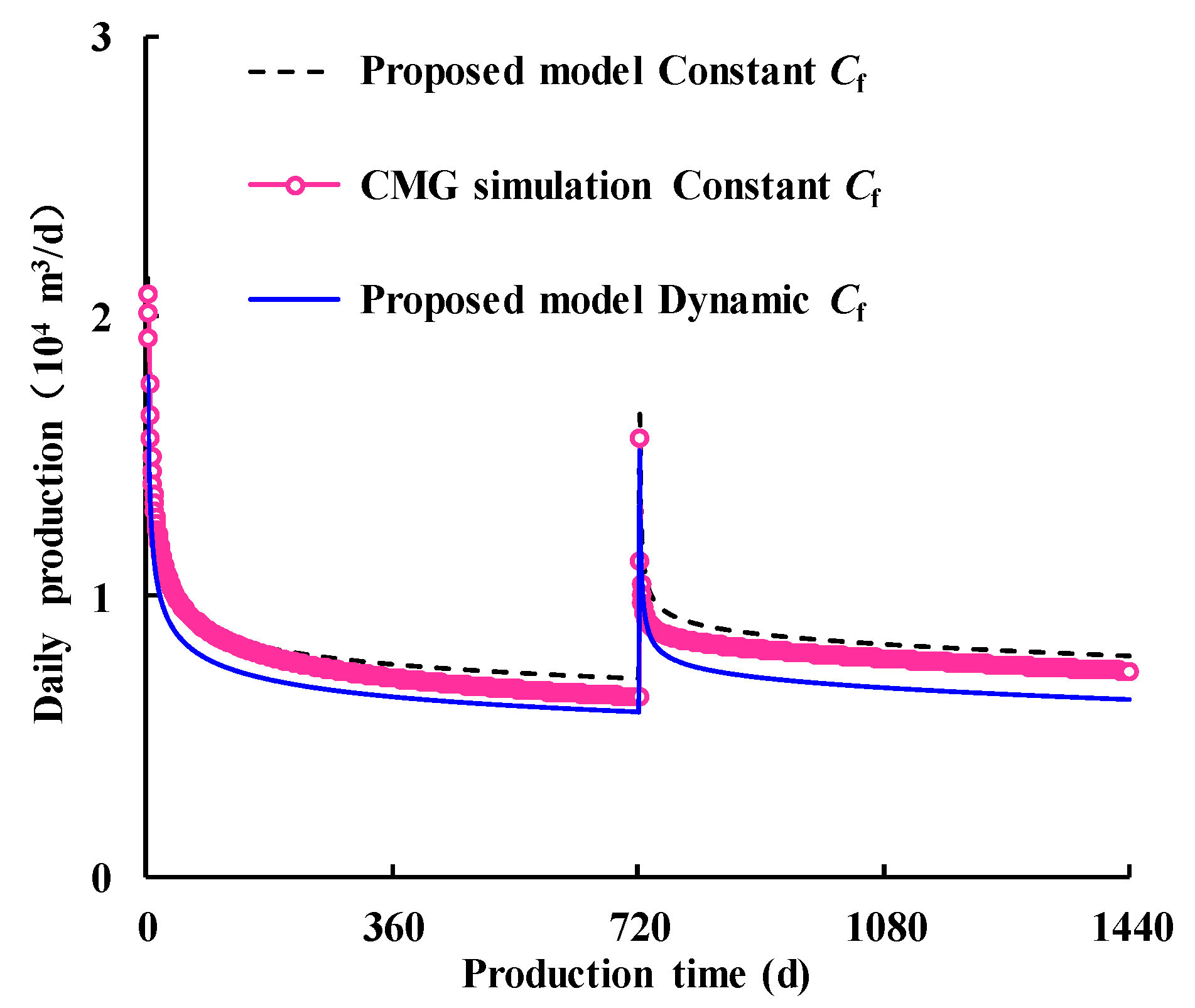





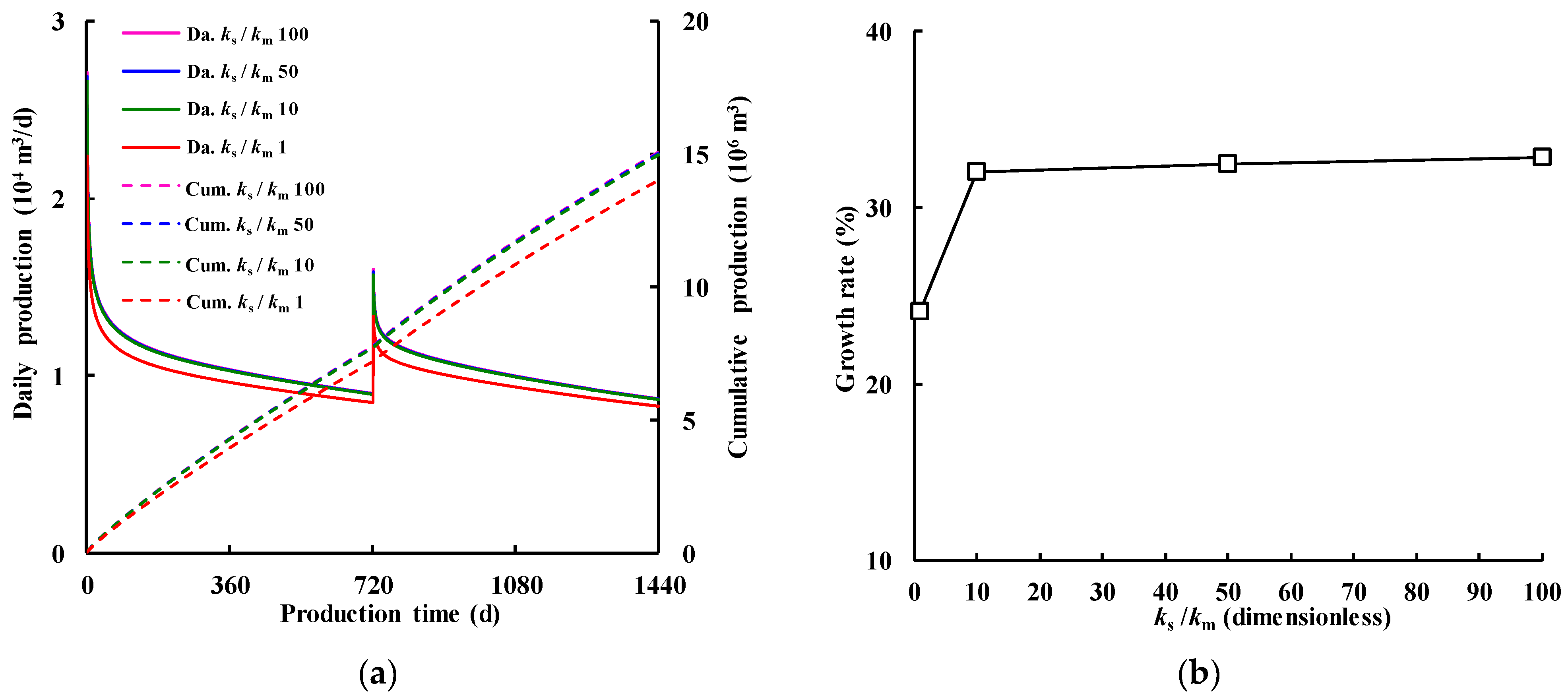
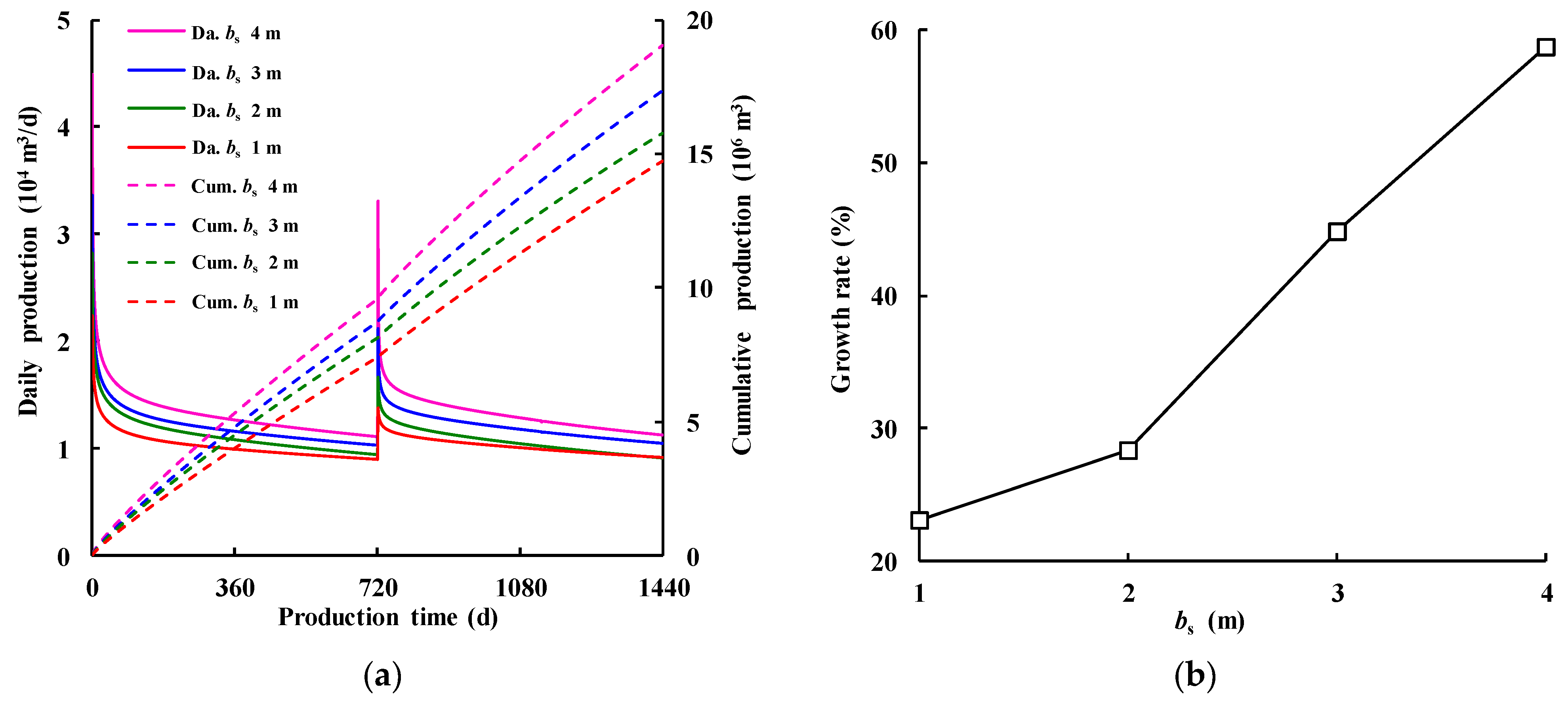

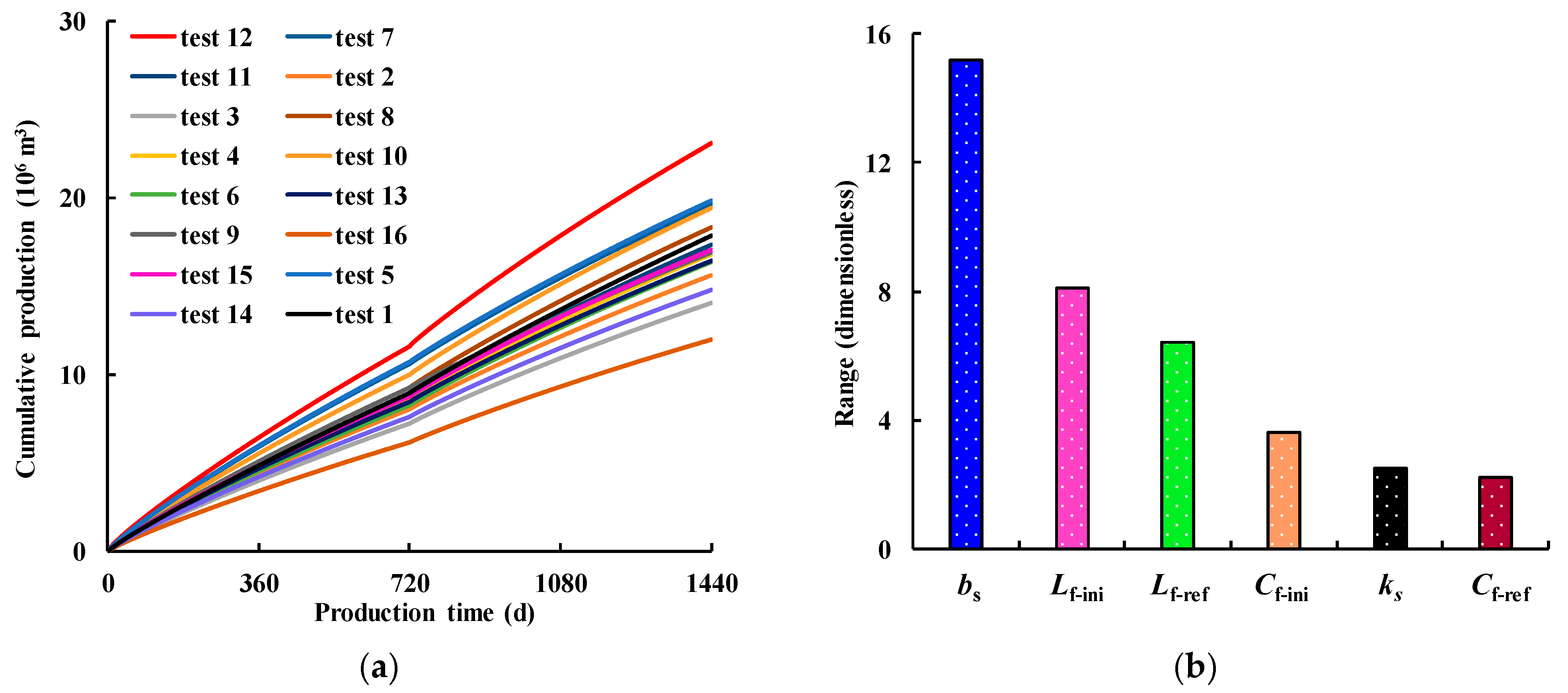
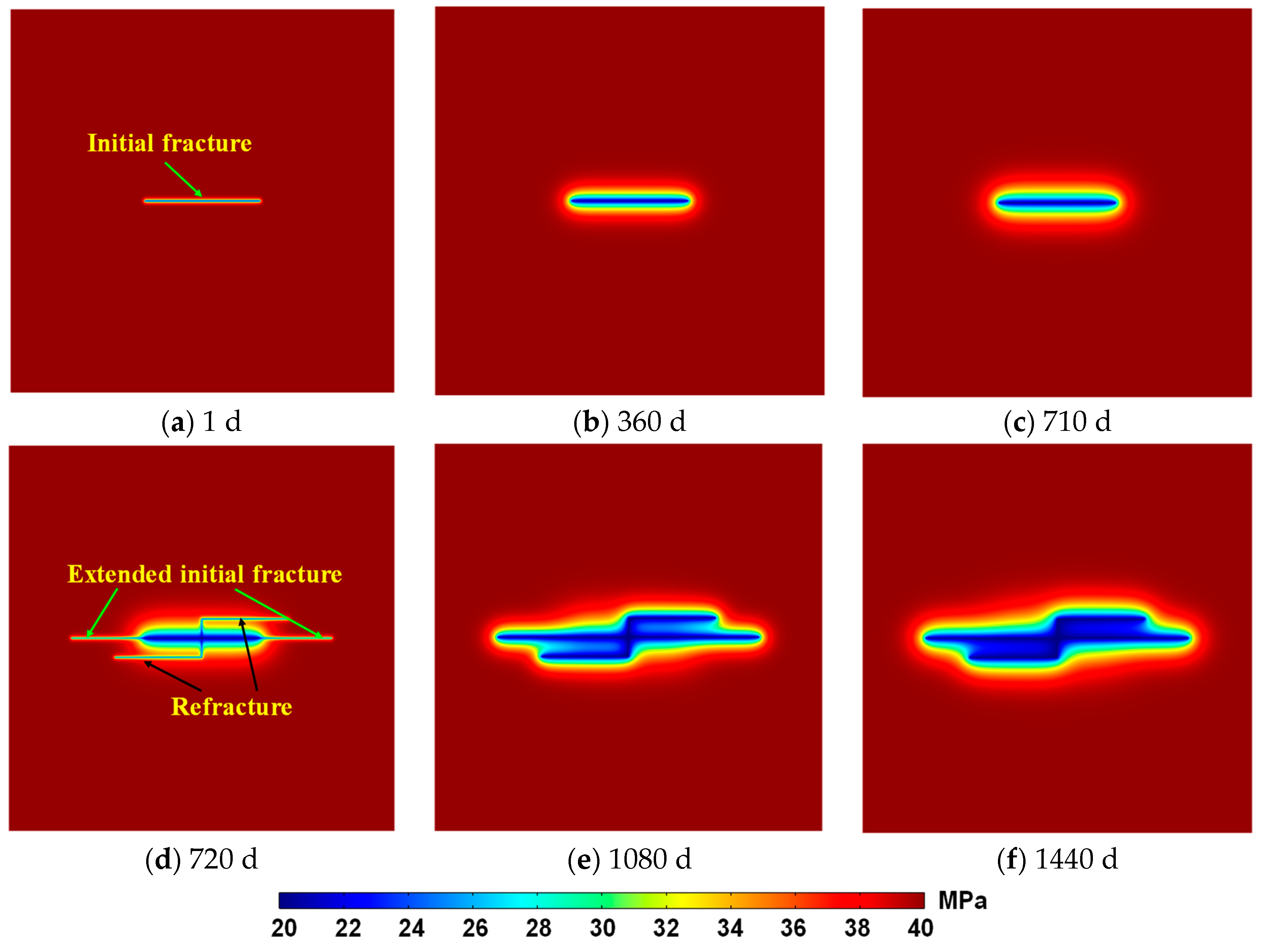
| Parameter | Unit | Value | Parameter | Unit | Value |
|---|---|---|---|---|---|
| Reservoir length | m | 800 | Segments of the initial fracture | — | 16 |
| Reservoir width | m | 800 | Segments of the refracture | — | 12 |
| Reservoir thickness | m | 20 | Fracture width | mm | 2 |
| Reservoir permeability | 10−3 μm2 | 0.1 | Gas deviation factor | — | 0.89 |
| Reservoir porosity | — | 0.16 | Gas relative density | — | 0.6 |
| Initial reservoir pressure | MPa | 40 | Gas viscosity at 341 K | mPa·s | 0.009 |
| Bottom-hole pressure | MPa | 20 | Gas constant | J/(mol·K) | 8.314 |
| Conductivity | D•cm | 6 | Gas density at 341 K | kg/m3 | 0.655 |
| Initial fracture length | m | 120 | Irreducible water saturation | % | 10 |
| Refracture fracture length | m | 120 | Compression factor | MPa−1 | 0.035 |
| No. | Lf-ini (m) | Lf-ref (m) | Cf-ini (D•cm) | Cf-ref (D•cm) | ks (mD) | bs (m) | No. | Lf-ini (m) | Lf-ref (m) | Cf-ini (D•cm) | Cf-ref (D•cm) | ks (mD) | bs (m) |
|---|---|---|---|---|---|---|---|---|---|---|---|---|---|
| Test 1 | 120 | 50 | 8 | 6 | 1 | 3 | Test 9 | 220 | 150 | 10 | 4 | 10 | 1 |
| Test 2 | 120 | 100 | 10 | 8 | 5 | 4 | Test 10 | 220 | 200 | 4 | 6 | 0.1 | 2 |
| Test 3 | 120 | 150 | 4 | 10 | 10 | 1 | Test 11 | 220 | 50 | 6 | 8 | 1 | 3 |
| Test 4 | 120 | 200 | 6 | 4 | 0.1 | 2 | Test 12 | 220 | 100 | 8 | 10 | 5 | 4 |
| Test 5 | 170 | 100 | 4 | 8 | 0.1 | 4 | Test 13 | 270 | 200 | 6 | 10 | 5 | 2 |
| Test 6 | 170 | 150 | 6 | 10 | 1 | 1 | Test 14 | 270 | 50 | 8 | 4 | 10 | 3 |
| Test 7 | 170 | 200 | 8 | 4 | 5 | 2 | Test 15 | 270 | 100 | 10 | 6 | 1 | 4 |
| Test 8 | 170 | 50 | 10 | 6 | 10 | 3 | Test 16 | 270 | 150 | 4 | 8 | 0.1 | 1 |
Disclaimer/Publisher’s Note: The statements, opinions and data contained in all publications are solely those of the individual author(s) and contributor(s) and not of MDPI and/or the editor(s). MDPI and/or the editor(s) disclaim responsibility for any injury to people or property resulting from any ideas, methods, instructions or products referred to in the content. |
© 2024 by the authors. Licensee MDPI, Basel, Switzerland. This article is an open access article distributed under the terms and conditions of the Creative Commons Attribution (CC BY) license (https://creativecommons.org/licenses/by/4.0/).
Share and Cite
Chen, Z.; Xu, Y.; Guo, B.; Zhao, Z.; Jin, H.; Liu, W.; Zhang, R. Refractured Well Hydraulic Fractures Optimization in Tight Sandstone Gas Reservoirs: Application in Linxing Gas Field. Processes 2024, 12, 2033. https://doi.org/10.3390/pr12092033
Chen Z, Xu Y, Guo B, Zhao Z, Jin H, Liu W, Zhang R. Refractured Well Hydraulic Fractures Optimization in Tight Sandstone Gas Reservoirs: Application in Linxing Gas Field. Processes. 2024; 12(9):2033. https://doi.org/10.3390/pr12092033
Chicago/Turabian StyleChen, Zhengrong, Yantao Xu, Bumin Guo, Zhihong Zhao, Haozeng Jin, Wei Liu, and Ran Zhang. 2024. "Refractured Well Hydraulic Fractures Optimization in Tight Sandstone Gas Reservoirs: Application in Linxing Gas Field" Processes 12, no. 9: 2033. https://doi.org/10.3390/pr12092033






